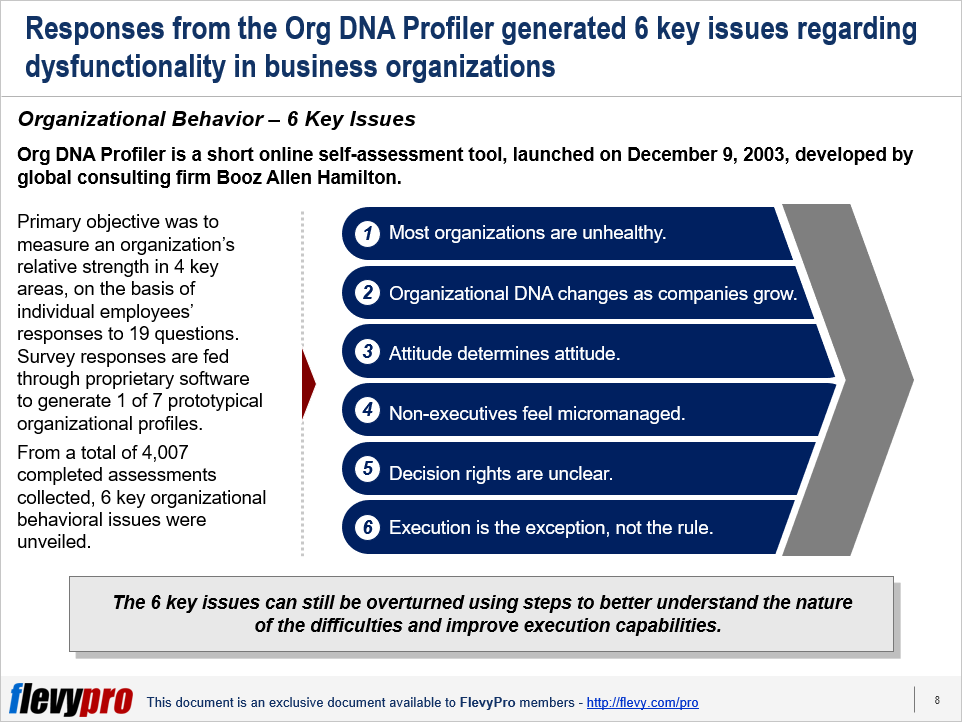Editor's Note: Take a look at our featured best practice, Smart Organizational Design (27-slide PowerPoint presentation). Business environment has transformed drastically and has become immensely challenging due to competition, disruptive technologies, laws, and globalization. These challenges warrant better performance to address customer needs and to survive--and outpace--intense competition.
Consequently, [read more]
Also, if you are interested in becoming an expert on Organizational Design (OD), take a look at Flevy's Organizational Design (OD) Frameworks offering here. This is a curated collection of best practice frameworks based on the thought leadership of leading consulting firms, academics, and recognized subject matter experts. By learning and applying these concepts, you can you stay ahead of the curve. Full details here.
* * * *
Most organizations are unhealthy. Only organizations that are recognized to be Resilient, Just-in-Time, and Military can be described and relatively free from dysfunction. Yet, only 27% of the responses gathered from the Org DNA Profiler showed a healthy profile.
and relatively free from dysfunction. Yet, only 27% of the responses gathered from the Org DNA Profiler showed a healthy profile.
The Org DNA Profiler is a short online self-assessment tool launched on December 9, 2003. It was used to measure an organization’s relative strength in 4 key areas, on the basis of individual employees’ responses to 19 questions. From a total of 4,007 completed assessments collected, there were 6 Organizational Behavioral issues that were prompted. These issues can still be turned around by undertaking the appropriate step.
The 6 Key Issues on Organizational Behavior
Organizational Behavioral Issues are observations on the prevalence of dysfunctions among business organizations.

- Most organizations are unhealthy. More than 60% of the organizations are either Passive-Aggressive, Fits-and-Starts, Outgrown, or Overmanaged.
- Organizational DNA changes as companies grow. Small companies report more Resilient and Just-in-Time behaviors. They become more centralized and demonstrate Military traits as they grow. Once annual revenues cross the $101B threshold, decentralization occurs. However, often this is undertaken badly.
- Attitude determines attitude. There are sharp differences between senior management and lower-level personnel. A disconnect exists between the organizations that senior executives believe they have established and the organizations they are actually running.
- Non-executives feel micromanaged. Junior managers feel a lack of maneuvering room compared to senior managers who view their self-professed involvement in operating decisions as good.
- Decision rights are unclear. More than 50% of the respondents believe that the accountability for decisions and actions in their organizations was vague.
- Execution is the exception, not the rule. Less than 50% of the respondents agreed that important strategic and operational decisions are quickly translated into action in their organizations.
It is expected that all organizations have behavioral issues. However, unlike humans and other organisms, organizations can change their DNA by adjusting and adapting their building blocks and resolve these issues. There are just processes that organizations must take into consideration to effectively address these behavioral issues and turn them around for the benefit and advantages of the organization.
The Need to Unlearn, Learn, and Relearn
It is advisable for an organization to continue to analyze its organization as it grows into and occasionally out of dysfunction. This can be done by using a 4-step evolutionary process.
Step 1: $0 – $500 Million. The first step or Step 1 generally demonstrates characteristics depicting Resilient or Just-in-Time profiles.
Organizations at this level are effective at executing and adapting to changes in the environment. They are generally younger small companies that are attuned to and aligned with the vision and strategy of the founders. They are known to be able to adapt more nimbly to market shifts.
Step 2: $500 Million – $1 Billion. The second step is an evolutionary phase where organizations are starting to experience the adverse effect of growth in terms of size. This is basically the stage where Military profile has reached its peak in revenue segment. These are the organizations that are bureaucratic, slow, and overly politicized. At this point, expanding middle management starts to second guess and interfere in lower-level decision making.
Step 3 is where organizations are becoming too large and step 4 is returning back to a Resilient profile. The 4-step evolutionary process reflects the stages of development of organizations as they start from being small to being large and complex. It is a reflection of the issues they are encountering at each step of development that they are in. Knowing where they are at this point will enable an organization to better undertake their Strategy Development in a most effective approach.
Interested in gaining more understanding of Organizational Behavioral Issues? You can learn more and download an editable PowerPoint about Organizational Behavioral Issues here on the Flevy documents marketplace.
Do You Find Value in This Framework?
You can download in-depth presentations on this and hundreds of similar business frameworks from the FlevyPro Library. FlevyPro is trusted and utilized by 1000s of management consultants and corporate executives. Here’s what some have to say:
“My FlevyPro subscription provides me with the most popular frameworks and decks in demand in today’s market. They not only augment my existing consulting and coaching offerings and delivery, but also keep me abreast of the latest trends, inspire new products and service offerings for my practice, and educate me in a fraction of the time and money of other solutions. I strongly recommend FlevyPro to any consultant serious about success.”
– Bill Branson, Founder at Strategic Business Architects
“As a niche strategic consulting firm, Flevy and FlevyPro frameworks and documents are an on-going reference to help us structure our findings and recommendations to our clients as well as improve their clarity, strength, and visual power. For us, it is an invaluable resource to increase our impact and value.”
– David Coloma, Consulting Area Manager at Cynertia Consulting
“As a small business owner, the resource material available from FlevyPro has proven to be invaluable. The ability to search for material on demand based our project events and client requirements was great for me and proved very beneficial to my clients. Importantly, being able to easily edit and tailor the material for specific purposes helped us to make presentations, knowledge sharing, and toolkit development, which formed part of the overall program collateral. While FlevyPro contains resource material that any consultancy, project or delivery firm must have, it is an essential part of a small firm or independent consultant’s toolbox.”
– Michael Duff, Managing Director at Change Strategy (UK)
“FlevyPro has been a brilliant resource for me, as an independent growth consultant, to access a vast knowledge bank of presentations to support my work with clients. In terms of RoI, the value I received from the very first presentation I downloaded paid for my subscription many times over! The quality of the decks available allows me to punch way above my weight – it’s like having the resources of a Big 4 consultancy at your fingertips at a microscopic fraction of the overhead.”
– Roderick Cameron, Founding Partner at SGFE Ltd
“Several times a month, I browse FlevyPro for presentations relevant to the job challenge I have (I am a consultant). When the subject requires it, I explore further and buy from the Flevy Marketplace. On all occasions, I read them, analyze them. I take the most relevant and applicable ideas for my work; and, of course, all this translates to my and my clients’ benefits.”
– Omar Hernán Montes Parra, CEO at Quantum SFE

30-slide PowerPoint presentation
The most resilient and consistently successful organizations have discovered that the devil is in the details. No company may ever totally master the enigma of execution. However, organizing to execute has truly become a source of Competitive Advantage.
Execution only becomes effective when the
[read more]
Want to Achieve Excellence in Organizational Design (OD)?
Gain the knowledge and develop the expertise to become an expert in Organizational Design (OD). Our frameworks are based on the thought leadership of leading consulting firms, academics, and recognized subject matter experts. Click here for full details.
Organizational Design (AKA Organizational Re-design) involves the creation of roles, processes, and structures to ensure that the organization's goals can be realized. Organizational Design span across various levels of the organization. It includes:
1. The overall organizational "architecture" (e.g. decentralized vs. centralized model).
2. The design of business areas and business units within a larger organization.
3. The design of departments and other sub-units within a business unit.
4. The design of individual roles.
In the current Digital Age, there is an accelerating pace of strategic change driven by the disruption of industries. As a result, to remain competitive, Organizational Design efforts are becoming more frequent and pervasive—with the majority of organizations having experienced redesign within the past 3 years. This has only been exacerbated by COVID-19.
Frustratingly, only less than a quarter of these Organizational Design efforts are successful. Most organizations lack the best practice know-how to guide them through these Transformations effectively.
Learn about our Organizational Design (OD) Best Practice Frameworks here.
Readers of This Article Are Interested in These Resources

22-slide PowerPoint presentation
Transformation initiatives are typically undertaken to solve a pressing issue, improve performance, or to serve customers better. These initiatives necessitate changing the existing behaviors of the employees across the organization. However, this isn't a straightforward task.
Ingrained
[read more]

22-slide PowerPoint presentation
What is Behavioral Strategy?
First, to understand Behavioral Strategy, we must first examine the concept of Cognitive Biases. There are 2 different types of biases in people that cause them to stray from rational decision making: cognitive and emotional. Cognitive biases arise due to
[read more]

21-slide PowerPoint presentation
This presentation provides a detailed understanding of the 4 Organizational Design (OD) elements that act as building blocks for yielding the desired behaviors in the workforce:
1. Organizational Structure
Organizational Structure represents the management reporting lines that create the
[read more]

27-slide PowerPoint presentation
Execution has become the new watchword in Boardrooms. As organizations fail to effectively implement strategies, the importance of execution has come to a fore. Essentially, the first step in resolving these dysfunctions is to understand how the inherent traits of an organization influence and
[read more]
 and relatively free from dysfunction. Yet, only 27% of the responses gathered from the Org DNA Profiler showed a healthy profile.
and relatively free from dysfunction. Yet, only 27% of the responses gathered from the Org DNA Profiler showed a healthy profile.




